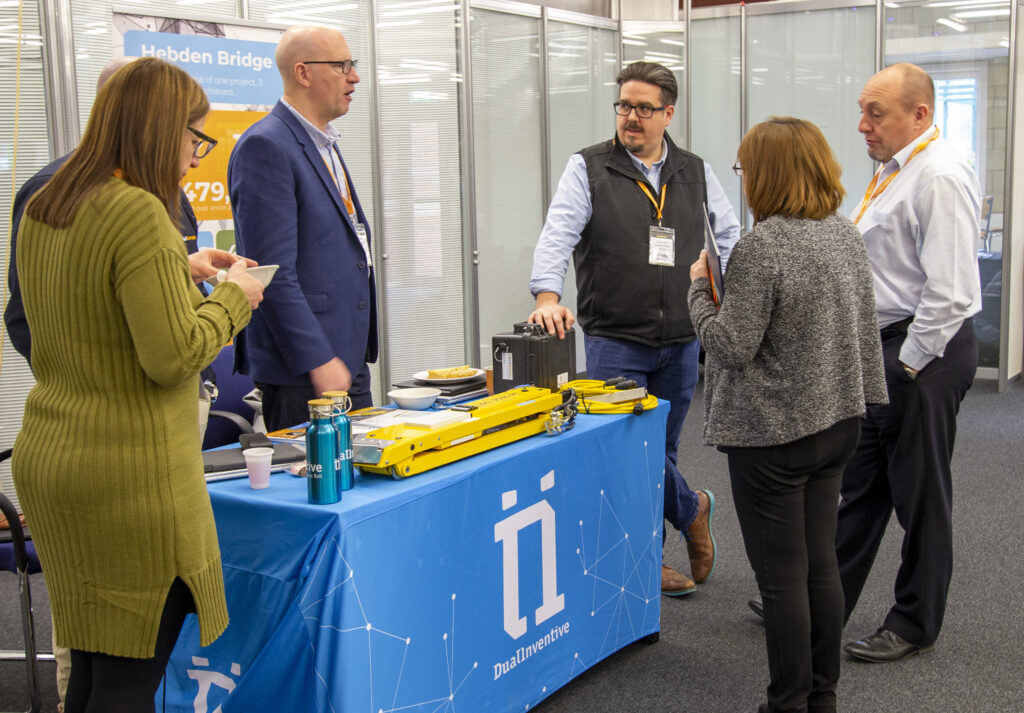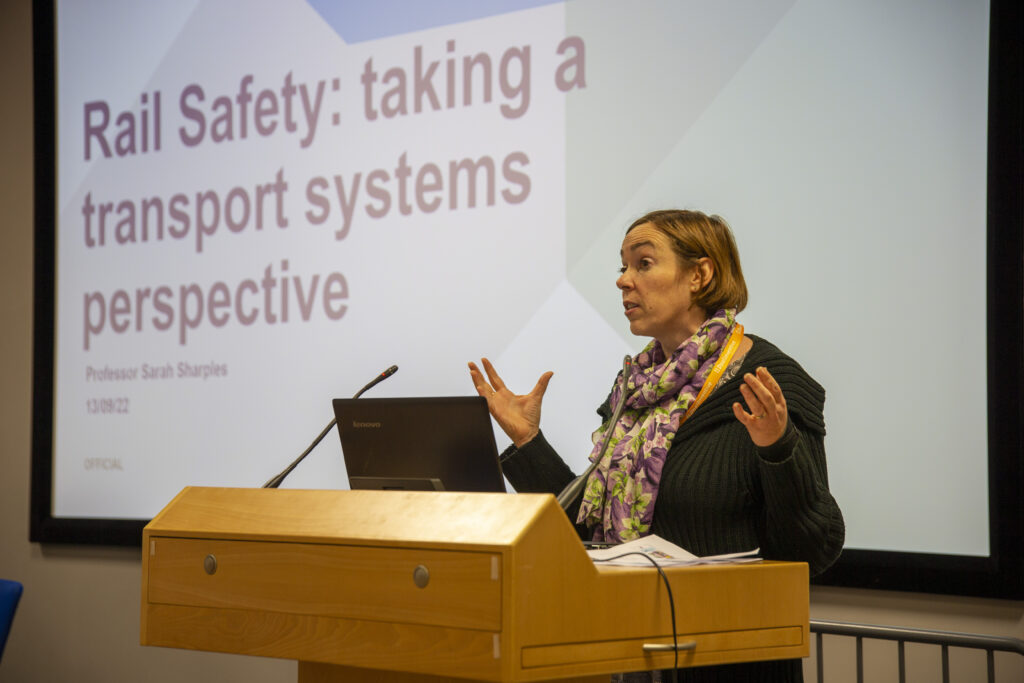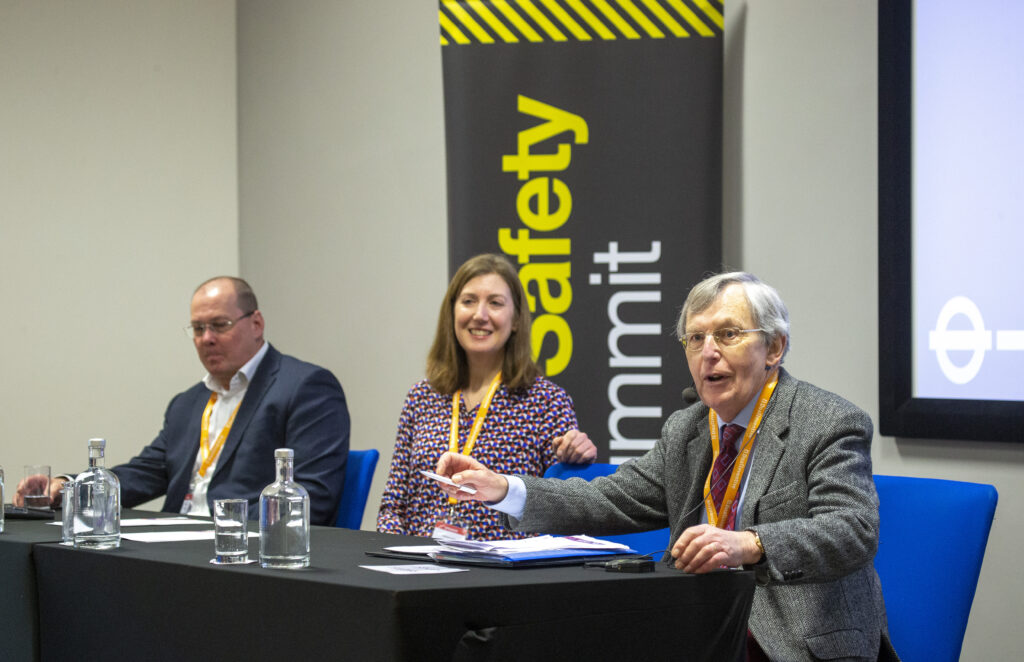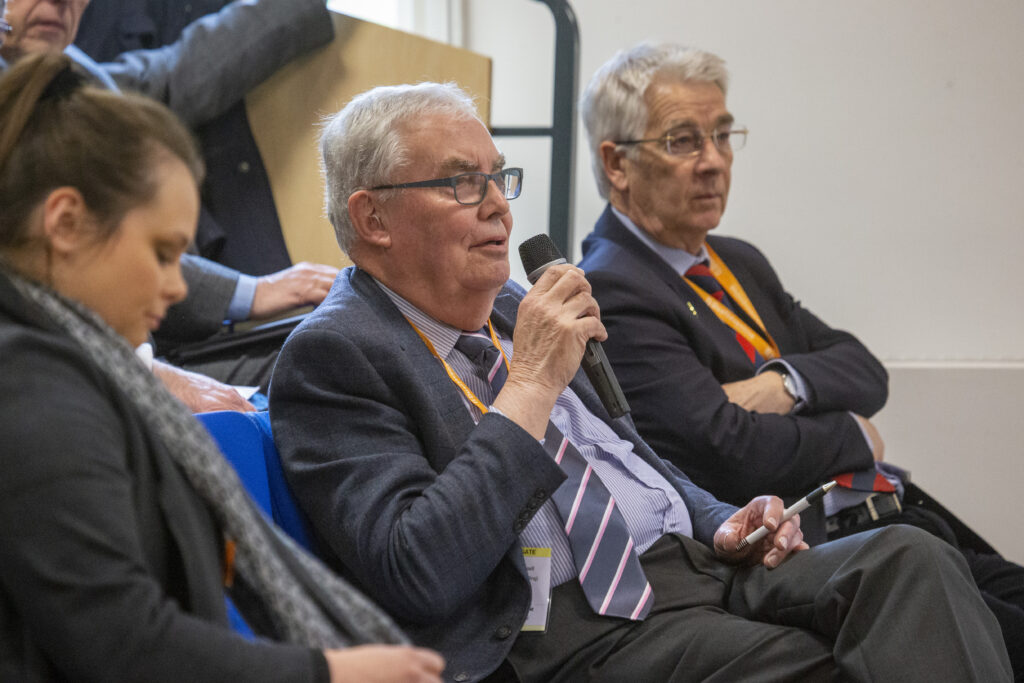The last in-person Rail Safety Summit was held in 2019, so it was good to once again re-assemble at Loughborough University on 14 March. With accidents and near misses still occurring too frequently, getting safety messages across is as important as ever and with 137 attendees present, many aspects of safety were covered. So, what is being done to improve safety and what are the factors and risks that cause most concern? The morning and afternoon sessions were chaired, respectively, by Colin Wheeler and myself, both retired career railwaymen but having had the distressing experience of staff being killed at the trackside.
Policy, strategy, and direction
It has long been emphasised that safety must be led from the top. In UK terminology, this means the Department for Transport (DfT), the Office of Rail and Road (ORR), and the Rail Standards and Safety Board (RSSB). The head of the ORR, Ian Prosser, gave a powerful message in a video recording.
Statistics show Britain has one of the safest railways in Europe, he said, but in the totality of rail covering main line, metros, trams, stations and platforms, the number of serious incidents still occurring is a worry. Three new factors to be considered are the post pandemic situation, climate change, and extreme weather events.
Several challenges exist, namely the management of change, organisational structure, attitudes, and use of technology. The industry’s financial situation and current industrial relations are not helping. There are some positive signs, however. For example, supporting people in health and wellbeing, particularly occupational health issues, is now more widespread.
Effective safety validation in the transition to Great British Railways (GBR) must be understood. The need to improve value for money in signalling systems without compromising safety, the prediction and location vulnerability of extreme weather and the means of worker access to the track, are things where technology has a major part to play.
The management of freight rolling stock is a concern and must be improved. The threat of legal action being taken against individuals and companies following accidents needs to be carefully thought through, with the forthcoming Sandilands tram accident prosecution being a test case.
With the premise that nobody sets out to deliberately cause a rail accident, does the legal framework on Health & Safety help people’s mindset when planning and delivering rail engineering and operations?
So, what is the government’s view? James Le Grice, the Head of Safety and Standards at the Department for Transport (DfT), spoke of investment, culture, and regulation – factors which all need to be interlinked with safety. The principal role of government is to ensure that the rail system works and that the regulatory regime and statutory legislation is fit for purpose, he said. Rail is a topic of public concern and questions are often asked at Prime Minister’s question time. Examples of topics recently subject to Acts of Parliament are Regulation of Guided Transport Systems (ROGTS), Interoperability, Private Level Crossing Signage, and the Licensing of Drivers.
Rail Accident reports are scrutinised carefully by the DfT, which gives the necessary focus on industry structure, Brexit, and the continuance of European standards. The result should be a proactive approach to future rail services and recognition of new risks. The Railways Act 2005 requires that the HLOS (High Level Output Statements) must include a safety and security section. Safety must not exist in a silo and must fit with future ambitions for rail, an example being rail freight growth. The government encourages promotion of UK rail expertise abroad, which includes rail safety where the UK record is very good.

Standards can be an emotive subject and Ali Chegini, the Director of System Safety and Health at the RSSB remarked on the difficulties of getting rail’s risk focus properly understood. Being an independent body, the RSSB’s influence extends to all in the rail sector – Network Rail, train operating companies (TOCs), freight operating companies (FOCs), metros, trams, and the huge supply chain industry. The aim is to work collaboratively and to bridge knowledge gaps. There is pressure on performance, and technology must offer safety efficiency plus value for money.
Boardroom thinking does not always view safety as a business risk or an opportunity to reduce cost. Safety and performance risks are an insidious mix of stubborn thinking where goals and strategies are unclear. Making the benefits become more obvious is important. The Carmont accident was caused by a linkage of rainfall, project and asset management weaknesses, as well as a misunderstanding of safe operation. The balancing of earthwork weaknesses with speed restrictions, and the maintenance of freight vehicles are the two major concerns. Whilst rail travel is generally viewed as safe, some risks are rising. The transition to GBR must maintain the safety culture. RSSB will keep a close eye on this and the whole industry will be involved.
For all three bodies, there is ongoing concern at the number of accidents and near misses that continue to happen. In the question session, much was made of the data. Can the management of data be improved, as sometimes it seems like a best kept secret? Are we measuring data in the right place and can it be processed in a more intelligent and focussed manner? The collection and interpretation of data should lead to the investigation and use of AI.
Understanding accidents
The Southall and Ladbroke Grove accidents of over 20 years ago led to the creation of the Rail Accident Investigation Branch (RAIB) and Andrew Hall, its third chief inspector, started his talk with the slogan ‘Beware! Rarely is not Never’. Whilst Rare is good, how rare is acceptable? A huge effort over 25 years has taken place to make the railways safer, so when accidents happen, they come as a shock.
Rarity means many people have never encountered an accident, he said, and sometimes this leads to ignorance of past recommendations and requirements. The Clapham accident of 1988 led to the IRSE Licensing Scheme as a means of establishing standards of competence amongst technicians, installers, designers, testers, and management in the signalling profession. Yet with all this, two recent events at Cardiff and Waterloo, which ignored the testing requirements, could have been much worse.
Two major accidents have occurred in recent times – Grayrigg in 2007 and Carmont in 2020 – with many smaller accidents in between. In his 1905 book ‘A Life of Reason’, the writer George Santayana made the quotation ‘Those who forget the past are destined to repeat it’. The RAIB’s reports aim to teach the causes of accidents so that people in all railway disciplines can learn directly from them. Studying the statistics and determining the correct investment criteria is all part of looking into the future.
The serious concern is freight containers where load distribution combined with track twist will inevitably lead to derailment – Camden and Duddeston being two examples. If the parameters change but the historic data does not change with it, it will lead to future accidents. When the norm suggests that accidents do not occur very often, there is little incentive to act. The growth in sending scrap metal to China is an example, with containers hopelessly unbalanced when loaded. Historic behaviour doesn’t predict people’s future actions, and everyone needs to be aware of this.
The Q&A session asked about disseminating rules and standards changes in a fragmented rail structure, where getting the message to staff is difficult. In British Rail (BR) days, there was a clear line of communication right down to technician level. Nowadays, the motivation to get changes introduced is limited and the understanding of rules at ground level is somewhat suspect. In response, accidents do not necessarily lead to a change in the rules. A plea was made for RAIB investigations and their recommendations to be carried out more quickly. Andrew Hall acknowledged this, but stressed that thoroughness and accuracy must be of prime importance.
Safety in Network Rail and London Underground
Infrastructure organisations probably have the greatest exposure to safety risks and must have robust safety processes in place. Rupert Lown, Network Rail’s chief health, safety and wellbeing officer, explained the company’s safety framework and safety expectations. Accident statistics covering everything from fatalities down to minor slips and trips, showed that incidents occurred every month between 2018 and 2022. Train collisions and accidents, whilst low in number, still revealed incidents in most months. Fatality incidents mean, for some families, a knock on the door to say that a loved one would not be coming home that day. Imagine the impact if that was you?
Under the banner ‘Everyone Home Safe Every Day’, six national elements to improve the statistics have been put in place.
Establishing a safety culture that is understood by everyone.
- Providing first line assurance to vulnerable staff with health issues.
- Having a leadership capability that understands safety.
- Communications and how to make this effective.
- Life saving rules to be established.
- Separation of people, trains, and machinery.

Each region has to create its own plan which, because of geography, and local engineering and operating conditions, will not necessarily be the same but must have the same outcome. Particular emphasis will be on tackling incidents of trespass and suicide, which show little sign of reducing.
Marion Kelly, Head of Safety, Health & Environment (SHE) at London Underground (LU), gave a similar message. With 1.38 billion journeys every year, and a huge portfolio of infrastructure assets and trains, it is not possible to operate a safe railway without people. Accidents in past years – Moorgate, Clapham, Kings Cross fire, Sandilands tram – resulted in changes being implemented and changed attitudes to accountability.
The Kings Cross fire was the wake up call and revolutionised LU’s attitude to safety. Senior managers did not see passenger safety as part of their job. Internal engineering expertise led to a blinkered self-sufficiency and unwillingness to take advice from outside bodies. Change has happened and will continue. The ambition is that by 2041, no-one will be killed or seriously injured on TfL networks or services. Factors being worked on are:
- Increased automation and digitising of networks and systems.
- Totally new thinking on culture and behaviour.
- Learning lessons from across the industry.
- Back-to-basics with rules and standards that are easier to understand and implement.
Feedback from all levels will be part of the process but one might question whether this timeframe is too long?
Electrification safety
Safety summits in the past have featured specific issues in the various engineering disciplines. Featured this time was electrification infrastructure with Peter Dearman, a career railwayman and an expert on electrification systems, giving a focus on associated safety risks.
Fortunately, there is no record of any passengers being killed whilst on a station platform but there are numerous examples of accidents involving track workers. The greatest risk is to staff working on the systems. Contact with 25kV is always catastrophic; contact with third rails, which are much closer to where trackside tasks are carried out, is life threatening. All work should be with equipment isolated and earthed. Accidents occur because:
- People stray outside of the isolation area.
- A failure to observe residual hazards within the isolation limits.
- Vulnerability of individuals to lapse in attentiveness; the human capacity for vigilance is not infinite.
The procedures for taking isolations are encapsulated in the Electricity at Work regulations and the Permit to Work processes. The opening and securing of switches plus connecting equipment to earth have well known rules but remember – ‘always test before touch’. Is enough done to train people and is there too much confidence in self-belief assumptions? A review of supervision and surveillance methods is needed. A question on boom-and-bust investment was particularly relevant to electrification as not only does the expertise in the design and build of electrified railways ebb away, but so does the culture of the associated safety. Whilst the issues are primarily engineering, the human factors are equally important.
Human behaviour
How companies look after and support workers was the question asked by John Jebson, the OHSE director at McGinley. The skill shortages in rail and engineering are well known but less obvious are recent national problems. Sixty-six percent of people are extremely worried about finance. Inflation is rampant with the average worker being £5,000 a year worse off. Financial literacy is not taught and 84% are not confident to talk about financial worries. During the pandemic, 54% of workers went to work knowing they had Covid. It all flags up significant mental health issues.
So, what to do about it? There is a need to ensure a fixed earning structure and move away from zero hours contracts. Education and training in financial matters is vital but where will this come from? There is a need to entice people into the rail industry which means a heavy responsibility on employing companies to create a sustainable workforce.

From a transport system perspective, the role is changing, so says Prof Sarah Sharples based at Nottingham University and Chief Scientific Advisor to the DfT. Decarbonisation, vehicle ownership, merging of road and rail (e.g., Very Light Rail) are some of the factors. Humans are brilliant but fallible; people, artefacts, and systems need to be integrated. Automation and innovation will be all important, but where does safety fit with this?
- Decarbonisation – limited action will have an impact on human health.
- Security – threats within society are a growing problem, particularly for women.
- Inclusion – higher numbers of disabled people wanting accessible mobility.
- Cost – transport charges, especially rail, are viewed as too high.
- Career change – today’s generation change jobs more frequently. Is safety transferable?
There is too much silo thinking and a whole system view is needed with much more shared practice between transport modes.
A better understanding of human weaknesses is required according to Jules Reed, head of behavioural science at Tended. People unconsciously take mental breaks (or daydream) averaging 70 minutes every day.
People interact and pick up both good and bad habits. For rail, this leads to loss of situational awareness, use of wrong access points, incorrect line identification, marker board irregularities, equipment left on track, all of which can cause rail accidents. Sadly, many past rail fatalities have resulted from workers striving to get work finished or a fault cleared, forgetting their own safe system of work with tragic consequences.
Safety at the coal face
Tracks, trains, and people do not mix. How to carry out lineside work safely was addressed by Nick Millington MBE. Now the route director for Network Rail Wales & Borders, Nick headed up the Safety Task Force project until January this year. Triggered by the tragedy at Margam in 2019, but mindful of other fatalities involving track workers, the project undertook a focussed investigation into how new work and maintenance tasks are carried out. The statistics do not make easy reading: 11% of planned work over the last 2.5 years was carried out under lookout or locally operated warning systems (LOWS) protection with 70% of near misses occurring under these conditions. Train speed and working in the proximity of switch and crossings are big factors.
The risk shift in trackside working, with lookout warning as a reference, shows that using LOWS is half as safe, having a line blockage is 40 times safer, and having a T3 possession is 200 times safer. Other risks are signaller error and working beyond the planned activities and location. There are 4.3 million maintenance works orders every year. Add to this new work and project tasks, one senses the challenge. Attending to faults with trains disrupted is difficult. Here again, the idea is for technicians and signallers to liaise and agree a time window for rectification. The line(s) will then be blocked and hopefully the fault will be rectified. If this does not happen, the technicians will withdraw and a new time slot in a quieter period will be agreed.
The Safety Task Force output is pushing for no more lookouts, 100% line blockages or train activated warning systems, and 100% compliance with safe working practices. Track Circuit Operating Devices (TCODs) are useful and remotely-controlled TCODs are being introduced. ‘Train on Line’ indicators and remote disconnection devices are being trialled. Keeping the work site safe also means better walkways, good access points, and fencing. Situational awareness is vital.
Line blockages are controversial; peak signaller workloads have to be taken into account and the time of day can be critical. The data on utilisation is improving: 25,000 line blocks are taken every week, an increase from 6% to 40% in recent times. Controller of Site Safety (COSS) and Person in Charge of Works (PICOW) training and certification needs to be overhauled.

Geofencing
Every year, trackside workers are involved in accidents and near-misses, a leading cause of which is a loss of situational awareness. A talk by Leo Scott Smith, CEO of Tended, explained how geofencing is becoming the next evolutionary step in trackside safety.
Last year, Tended launched an innovative solution that combines geospatial technology and behavioural science to address the loss of situational awareness and help end preventable accidents. Using an online dashboard, users can plot out safe working zones with associated access points to precision. A wearable device assigned to the site then alerts workers in real time if they cross a geofence boundary and leave safe working limits.
The system uses a well-established network to achieve unprecedented accuracy within 14mm, and it is very quick to set up and simple to use. Having received product acceptance from Network Rail, it is now being deployed on the UK’s railway infrastructure.
A resounding success
By all accounts this year’s Rail Safety Summit was a resounding success, with attendees praising the presentations delivered and the high-level of debate they generated. Continued efforts to get the safety messages across are vital and the Safety Summit is set to return in 2024.
For further information visit www.railsummits.com.

